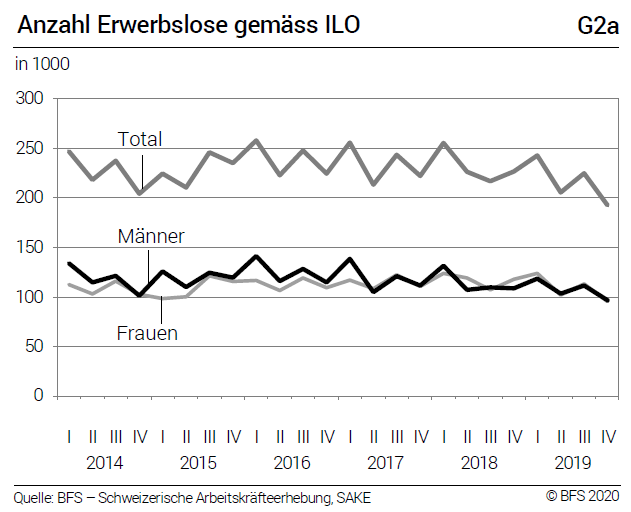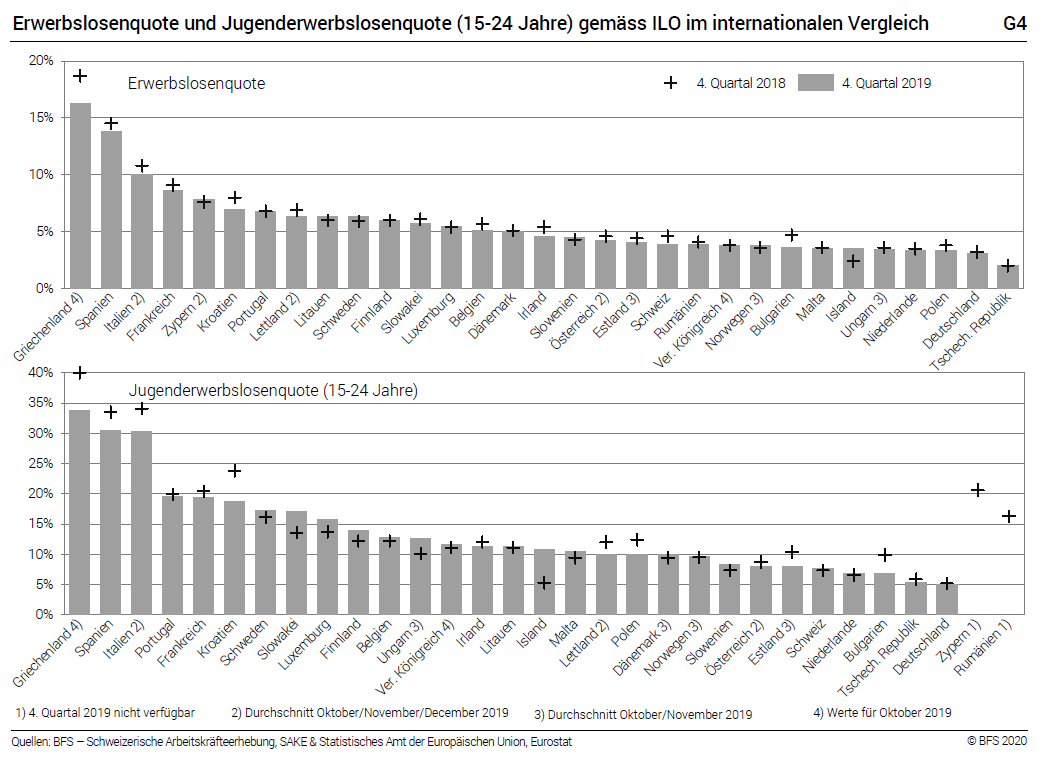13.02.2020 – The number of employed persons in Switzerland rose by 0.9% between the 4th quarter 2018 and the 4th quarter 2019. During the same period, the unemployment rate as defined by the International Labour Organisation (ILO) declined from 4.6% to 3.9%. The EU’s unemployment rate based also decreased from 6.6% to 6.2%. These are some of the results of the Swiss Labour Force Survey (SLFS).
Download press release: 4th quarter 2019: 0.9% increase in number of employed persons; unemployment rate based on ILO definition falls to 3.9%
Translated from German:
| The number of people in employment in Switzerland increased by 0.9% between the fourth quarter of 2018 and the fourth quarter of 2019. During the same period, the unemployment rate declined from 4.6% to 3.9% as defined by the International Labor Office (ILO). In the European Union (EU), the unemployment rate fell from 6.6% to 6.2%. This comes from the Swiss labor force survey (SAKE).A total of 5,130 million people were employed in Switzerland in the fourth quarter of 2019, 0.9% more than in the fourth quarter of 2018. The number of employed men rose by 0.2%, that of employed women by 1.7% , Full-time equivalents (FTE) showed an increase of 0.6% compared to the same quarter of the previous year (men: + 0.1%; women: + 1.4%). Seasonally adjusted, the number of people in employment and the number of FTE increased by 0.3% between the 3rd and 4th quarter of 2019. |
Unemployed According to ILO, Q1 2014-Q4 2019 |
Swiss and foreign workersBetween the fourth quarter of 2018 and the fourth quarter of 2019, the number of foreign workers rose by 1.7% and that of Swiss workers by 0.5%. The increase among cross-border workers was greatest among foreign workers (G pass: + 4.5%). Part of this increase is due to a technical effect (see methodological appendix). This is followed by the people with a settlement permit (ID card C: + 1.1%) and the people with a residence permit (ID card B or L, in Switzerland for at least twelve months: + 0.7%). By contrast, the number of people in employment with a short-term residence permit (permit L, in Switzerland for less than twelve months) fell (–4.5%). Unemployment in Switzerland and EuropeIn the fourth quarter of 2019, 192,000 people were unemployed in Switzerland as defined by the ILO. That is 34,000 fewer than a year earlier. The share of the unemployed in the labor force was 3.9%, lower than in the fourth quarter of 2018 (4.6%). Seasonally adjusted, the unemployment rate fell from 4.3% to 4.1% compared to the previous quarter. Between the fourth quarter of 2018 and the fourth quarter of 2019, the unemployment rate decreased both in the European Union (EU28: from 6.6% to 6.2%) and in the euro area (EZ19: from 7.9% to 7 , 5%). youth unemploymentIn Switzerland, the youth unemployment rate (15- to 24-year-olds) rose from 7.3% to 7.7% between the fourth quarter of 2018 and the fourth quarter of 2019 according to the ILO. Over the same period, the youth unemployment rate fell both in the European Union (EU28: from 14.7% to 14.0%) and in the euro area (EZ19: from 16.3% to 15.2%). Unemployment according to different characteristics
|
Unemployment Rate and Youth Unemployment Rate, Q4 2019 |
Tags: newsletter,Switzerland Unemployment Rate























